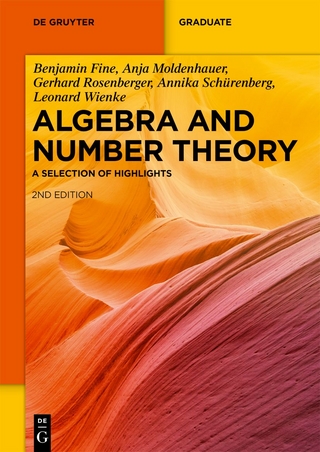
A Course in Constructive Algebra
Springer-Verlag New York Inc.
978-0-387-96640-3 (ISBN)
I. Sets.- 1. Constructive vs. classical mathematics.- 2. Sets, subsets and functions.- 3. Choice.- 4. Categories.- 5. Partially ordered sets and lattices.- 6. Well-founded sets and ordinals.- II. Basic Algebra.- 1. Groups.- 2. Rings and fields.- 3. Real numbers.- 4. Modules.- 5. Polynomial rings.- 6. Matrices and vector spaces.- 7. Determinants.- 8. Symmetric polynomials.- III. Rings And Modules.- 1. Quasi-regular ideals.- 2. Coherent and Noetherian modules.- 3. Localization.- 4. Tensor products.- 5. Flat modules.- 6. Local rings.- 7. Commutative local rings.- IV. Divisibility in Discrete Domains.- 1. Cancellation monoids.- 2. UFD's and Bézout domains.- 3. Dedekind-Hasse rings and Euclidean domains.- 4. Polynomial rings.- V. Principal Ideal Domains.- 1. Diagonalizing matrices.- 2. Finitely presented modules.- 3. Torsion modules, p-components, elementary divisors.- 4. Linear transformations.- VI. Field Theory.- 1. Integral extensions and impotent rings.- 2. Algebraic independence and transcendence bases.- 3. Splitting fields and algebraic closures.- 4. Separability and diagonalizability.- 5. Primitive elements.- 6. Separability and characteristic p.- 7. Perfect fields.- 8. Galois theory.- VII. Factoring Polynomials.- 1. Factorial and separably factorial fields.- 2. Extensions of (separably) factorial fields.- 3. Condition p.- 4. The fundamental theorem of algebra.- VIII. Commutative Noetherian Rings.- 1. The Hilbert basis theorem.- 2. Noether normalization and the Artin-Rees lemma.- 3. The Nullstellensatz.- 4. Tennenbaum' s approach to the Hilbert basis theorem.- 5. Primary ideals.- 6. Localization.- 7. Primary decomposition.- 8. Lasker-Noether rings.- 9. Fully Lasker-Noether rings.- 10. The principal ideal theorem.- IX. Finite Dimensional Algebras.- 1. Representations.- 2. The density theorem.- 3. The radical and summands.- 4. Wedderburn's theorem, part one.- 5. Matrix rings and division algebras.- X. Free Groups.- 1. Existence and uniqueness.- 2. Nielsen sets.- 3.Finitely generated subgroups.- 4. Detachable subgroups of finite-rank free groups.- 5. Conjugate subgroups.- XI. Abelian Groups.- 1. Finite-rank torsion-free groups.- 2. Divisible groups.- 3. Height functions on p-groups.- 4. Ulm's theorem.- 5. Construction of Ulm groups.- XII. Valuation Theory.- 1. Valuations.- 2. Locally precompact valuations.- 3. Pseudofactorial fields.- 4. Normed vector spaces.- 5. Real and complex fields.- 6. Hensel's lemma.- 7. Extensions of valuations.- 8. e and f.- XIII. Dedekind Domains.- 1. Dedekind sets of valuations.- 2. Ideal theory.- 3. Finite extensions.
| Reihe/Serie | Universitext |
|---|---|
| Zusatzinfo | 1 Illustrations, black and white; XI, 344 p. 1 illus. |
| Verlagsort | New York, NY |
| Sprache | englisch |
| Maße | 155 x 235 mm |
| Themenwelt | Mathematik / Informatik ► Mathematik ► Algebra |
| ISBN-10 | 0-387-96640-4 / 0387966404 |
| ISBN-13 | 978-0-387-96640-3 / 9780387966403 |
| Zustand | Neuware |
| Informationen gemäß Produktsicherheitsverordnung (GPSR) | |
| Haben Sie eine Frage zum Produkt? |
aus dem Bereich


